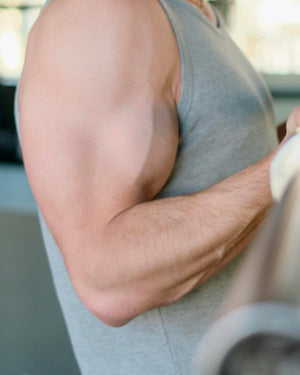Pull-ups are among the most iconic exercises in bodybuilding. Whether you're a beginner or an experienced practitioner, this bodyweight exercise is a real asset for developing a powerful and balanced upper body . Whether performed with a pronation, supination, or neutral grip, pull-ups target a multitude of muscles and offer infinite progression.
Discover in this article the keys to mastering pull-ups and effectively integrating them into your training program.
Pull-ups: An essential multi-joint exercise
Pull-ups are a multi-joint strength training exercise . They work multiple joints and muscle groups simultaneously, providing a comprehensive and effective workout. By lifting yourself using your arms and back while hanging from a fixed bar , the body engages a large number of muscles. Each repetition, performed correctly, not only builds muscle strength, but also coordination and stability.
The impact of the grip on the muscles used
One of the fascinating aspects of pull-ups is their adaptability. Depending on the grip adopted (pronation, supination, or neutral), the targeted muscles vary slightly, allowing you to customize the exercise according to specific goals or needs. For example:
- Pronation: Put more emphasis on the back.
- Supination: Engage the biceps more while working the back.
- Neutral Grip: Create balance by engaging both the arms and back.
This choice of grip allows you to diversify your workouts and avoid stagnation, while developing a harmonious physique.
Muscles used in pull-ups
Pull-ups involve a complete muscle chain, making them an essential basic exercise in bodybuilding.
- Back: The latissimus dorsi, trapezius, and rhomboid muscles are the primary drivers of body elevation. These muscles help pull body weight while stabilizing the shoulder blades. With this engagement, pull-ups are particularly effective for developing the famous " V-shaped back ," a symbol of a powerful and balanced physique.
- Arms: The biceps brachii, brachioradialis, and forearm flexors play a key role in bending the elbows during the pull. These muscles help coordinate the pulling motion while providing sufficient force to overcome gravity.
- Shoulders and Forearms: The deltoids, along with the forearm muscles, work to maintain a firm grip on the bar and stabilize the body while hanging. Grip strength is essential for successful repeated pull-ups.
- Abdominals: By strengthening the core, the abdominals help maintain a stable posture and prevent swaying. They also play a vital role in controlling movement, particularly when descending.
Thanks to this overall solicitation, pull-ups offer an excellent ratio between effort and results , which makes them essential in any program focused on sports nutrition, bodybuilding and improving physical performance.
Pull-up Variations: Options for All Levels
Once you've mastered the basics, you can progress and target muscle groups differently with the many pull-up variations. Here's a detailed look at the main options:
Pronation pull-up
The overhand pull-up , also called the "pull-up," is a classic variation. By gripping the bar with your palms facing forward, this exercise strongly engages the lats and lower trapezius muscles . This type of pull-up is ideal for widening the back and developing overall upper body strength . However, it is a more demanding version, requiring good starting strength.
Supine pull-up
The supine pull-up , also known as a chin-up, is more accessible, especially for beginners. This variation engages the biceps more pronouncedly while working the lats. It is often used to improve arm definition and complement the work done in pronation.
Learn more about supination traction
Neutral grip
The neutral grip, where the palms face each other, offers a balanced alternative. This variation combines arm and back work while limiting shoulder strain. It's particularly popular for its comfort and long-term effectiveness.
Weighted pull-ups
Experienced athletes can incorporate weighted pull-ups to continue their progress. By adding a weighted vest or belt, the intensity of the exercise increases, promoting maximum strength gains. This method is ideal for athletes who have already mastered traditional pull-ups and are looking for a new challenge.
Wide and tight grips
- Wide grip: This primarily works the lats and is ideal for those looking to develop back width. Be careful, however, not to over-extend the hand spacing, which could limit the range of motion.
- Close Grip: This variation targets the trapezius and arm muscles. It is ideal for working the depth of the back and improving muscular endurance.
The benefits of a versatile exercise
Pull-ups don't just build strength . They offer a host of additional benefits that make them a must-do exercise:
- Improved posture: By strengthening the back muscles , they correct imbalances caused by prolonged sitting.
- Functional Strength: Pull-ups mimic natural movements, improving everyday performance.
- Metabolic stimulation: Working multiple muscle groups at the same time results in high energy expenditure, which is useful for fat loss.
Thanks to their adaptability and quick results, pull-ups are a staple in any well-structured training program.
How to start and progress in pull-ups?
Achieving your first pull-up can be a challenge, but with structured training, this goal becomes attainable. Here are the key steps to success:
1. Strengthen targeted muscles
Before attempting a supine pull-up , it's important to strengthen the muscles involved . Incorporate exercises like high pulley lat pulldowns , bicep curls , and rows . These exercises will help you build strength in your arms and back. This will mobilize a muscle group to work together.
2. Use assisted pull-ups
Band-assisted pull-ups are perfect for beginners. A band attached to the bar will help you lift by reducing the weight you have to pull.
3. Practice negative pull-ups
Start at the top of the movement (chin above the bar) and slowly lower yourself back down. This eccentric phase strengthens the muscles while learning the movement.
4. Structure your sessions
Vary your grips and the intensity of your sets. Consult our article on how many times a week to help you plan your workouts optimally.
5. Pyramid training
A pyramid program is effective for improving strength and endurance. Start with one repetition, then gradually increase to a maximum before decreasing.
Pull-ups and sports nutrition
Successful pull-ups also depend on proper nutrition. The muscles being worked need nutrients to rebuild and strengthen. Here are some tips:
- Proteins: Essential for recovery, they are found in whey or protein powder . These supplements are ideal for athletes looking to maximize their results.
- Hydration: Drinking water before, during and after training improves performance and limits the risk of injury.
- Dietary supplements: Specific products such as sports dietary supplements help improve endurance and recovery.
Optimize your pull-ups with a structured program
Muscle groups to work together
For rapid progress, be sure to organize your workouts based on the muscles you're working. For example, combine back work with biceps to maximize your performance.
Guide: Which muscles to work together
Sample Weekly Schedule
- Day 1: Back and biceps (pull-ups, high pulley rows, bicep curls)
- Day 2: Rest
- Day 3: Shoulders and abs
- Day 4: Rest
- Day 5: Pull-ups and variations
- Day 6: Legs
- Day 7: Rest or stretching
Common Mistakes to Avoid
Unnecessary swings
When performing pull-ups, a controlled movement is essential. Excessive swinging not only reduces the effectiveness of the exercise but also increases the risk of injury.
Partial amplitude
Not lowering all the way down or not raising high enough decreases the effectiveness of each repetition. Focus on a full range of motion.
Bad alignment
Posture is essential to avoid injury. Maintain a neutral spine and avoid hyperextension.
Neglecting recovery
To progress, it's important to allow your muscles to recover. Plan rest days and eat a balanced diet to promote muscle regeneration.
The benefits of daily pull-ups
Pull-ups not only strengthen your muscles, they also offer functional benefits:
- Improved posture: By engaging the back muscles , pull-ups help maintain an upright posture.
- Functional Strength: The movements involved in pull-ups mirror natural gestures, improving your overall fitness .
- Balanced Development: By working multiple muscle groups, pull-ups promote balanced upper body development.
Sources:
- Misconceptions About Youth Weight Lifting-Reply
Michel J, Bernier A, Thompson LA.
JAMA Pediatr. 2022 Oct 1;176(10):1052. doi: 10.1001/jamapediatrics.2022.3066.
PMID: 36036904: https://pubmed.ncbi.nlm.nih.gov/36036904/ - Fundamentals of Resistance Training: Progression and Exercise Prescription
Kraemer WJ, Ratamess NA.
Med Sci Sports Exercise 2004 Apr;36(4):674-88. doi: 10.1249/01.mss.0000121945.36635.61.
PMID: 15064596: https://pubmed.ncbi.nlm.nih.gov/15064596/ - Physiology of Soccer: An Update
Stølen T, Chamari K, Castagna C, Wisløff U.
Sports Med. 2005;35(6):501-36. doi:10.2165/00007256-200535060-00004.
PMID: 15974635: https://pubmed.ncbi.nlm.nih.gov/15974635/ - Weight Lifting in the Human Brain
de Lange FP.
J Neurosci. 2006 Oct 11;26(41):10327-8. doi: 10.1523/jneurosci.3867-06.2006.
PMID: 17039615: https://pubmed.ncbi.nlm.nih.gov/17039615/














